 |
 |
 |
| |
Genotypic, Phenotypic and Virtual Phenotypic Resistance Patterns for Darunavir and Tipranavir: An Independent Analysis of a Quebec HIV-1 Cohort Highly Resistant to all Other Protease Inhibitors
|
| |
| |
Reported by Jules Levin
18th Intl HIV Drug Resistance Workshop June 9-12 2009 Ft Myers Florida
Annie Talbot1, 2, Philip Grant 2, Jonathan Taylor2, Jean-Guy Baril1, Hugues Charest3, Tommy Liu 2, Bluma Brenner 4, Michel Roger1, Robert Shafer2, Regis Cantin3, Andrew Zolopa2
1Centre hospitalier de l'universite de Montreal, Montreal, Quebec, 2Stanford University, Palo Alto, CA, 3 Institut national de sante publique du Quebec/Laboratoire de sante publique du Quebec, Ste-Anne-de-Bellevue, Quebec4, Centre universitaire de sante McGill, Montreal, Quebec
AUTHOR CONCLUSIONS
In this independent clinical dataset comprised of patients with highly resistant to PIs, resistance to DRV and TPV was rare.
All GIS performed reasonably well in predicting darunavir susceptibility (R2=0.38-0.70).
The Vircotype was unique in its ability to predict tipranavir susceptibility (R2=0.80 vs. 0.00, 0.18, 0.32 and 0.33 for the other scores).
Stanford HIVdb performed substantially better when the continuous score was used rather than the categorized score.
In our dataset, the presence of 84V, 82T, and lack of 10F favored darunavir over tipranavir in multivariate analysis.
The presence of 54L, 32I, and 47V favored tipranavir over darunavir.
In particular, an isolate with 54L, 47V, and 32I was substantially more likely to be susceptibile to TPV (OR=4.4) and their presence, especially in combination, may identify a patient population that may benefit from TPV over DRV
ABSTRACT
Background
Darunavir and tipranavir remain active against HIV isolates resistant to earlier generation protease inhibitors (PIs). Genotypic interpretation systems (GIS) are available to predict susceptibility to darunavir and tipranavir, but few independent datasets have been used to test their performance. We selected a set of highly resistant clinical isolates to test performance of various GIS and develop models to predict relative susceptibility to darunavir and tipranavir.
Methods
Since 2005, Vircotype virtual phenotype has been used for interpretation of all genotypic resistance tests in Quebec. A phenotype was performed on isolates predicted to be resistant to all PIs except darunavir and tipranavir. We constructed linear regression models to predict relative phenotypic susceptibility to darunavir or tipranavir, confirmed by bootstrap analyses. We compared the performance of ANRS, the Stanford HIV database, Vircotype, and darunavir and tipranavir manufacturers' scores in predicting phenotype.
Results
Phenotypic testing was performed on 100 isolates. 89 isolates were susceptible to darunavir. Of these, 67 were susceptible, 16 intermediate, and 6 resistant to tipranavir.
Two and 3 isolates were intermediate and resistant to darunavir, respectively, with full susceptibility to tipranavir. Four isolates were resistant to darunavir with intermediate resistance to tipranavir. Only 2 isolates were resistant to both darunavir and tipranavir.
In bootstrap analyses, presence of 84V, 82T, and 35D and lack of 10F were the strongest predictors of relative susceptibility to darunavir compared to tipranavir. Presence of 54L, 32I, and 47V predicted isolates relatively susceptible to tipranavir compared to darunavir. All GIS performed well in predicting the darunavir phenotype (R2 = 0.61-0.69). However, for tipranavir, the GIS were not as predictive of the phenotype with R2 of 0.03-0.31. Vircotype was unique in its ability to predict tipranavir susceptibility (R2 =0.80).
Conclusion
In this independent clinical cohort with highly PI-resistant HIV, phenotypic resistance to darunavir and tipranavir was rare. GIS, other than the virtual phenotype, do not perform well in predicting tipranavir susceptibility, while all GIS perform reasonably well in predicting darunavir phenotypic susceptibility. The mutations 54L, 32I, and/or 47V in protease predict isolates that may be more susceptible to tipranavir than darunavir.
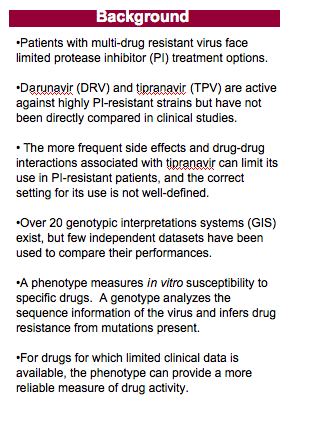
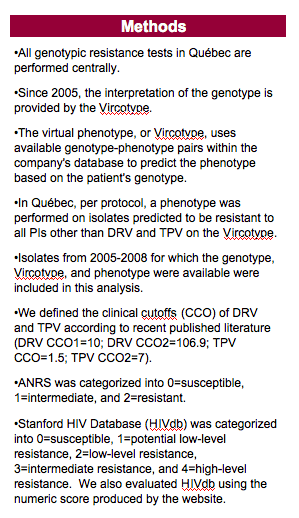
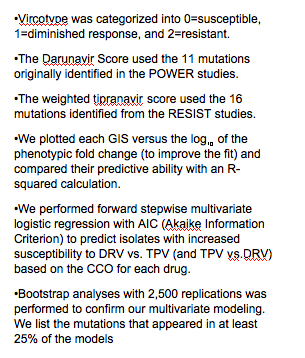
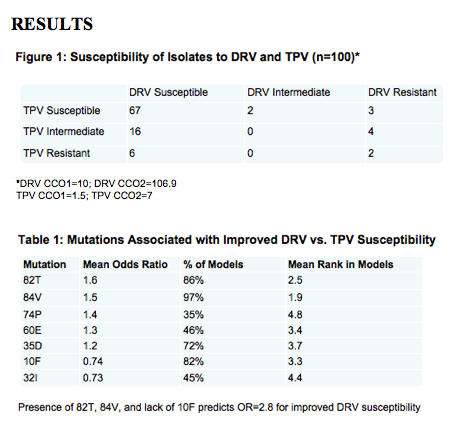
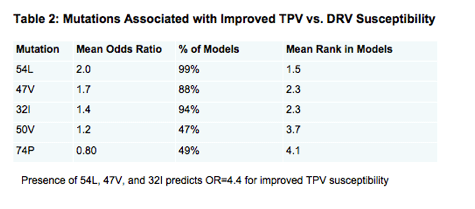
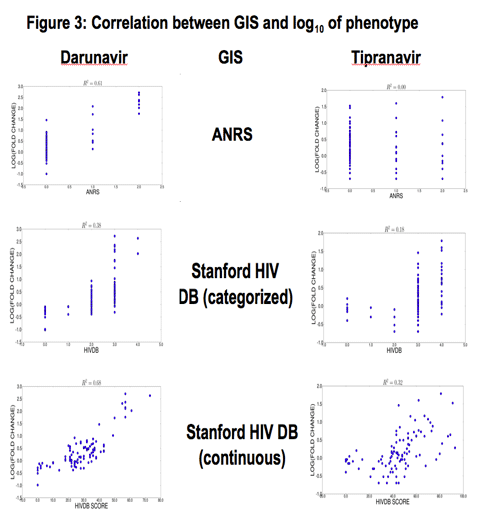
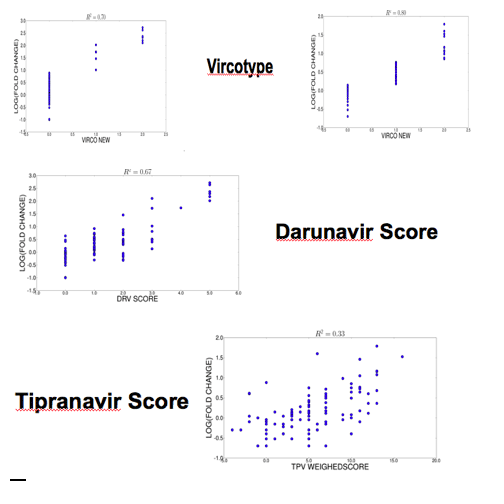
|
| |
|
 |
 |
|
|